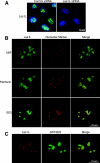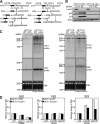Las1L is a nucleolar protein required for cell proliferation and ribosome biogenesis
- PMID: 20647540
- PMCID: PMC2937536
- DOI: 10.1128/MCB.00358-10
Las1L is a nucleolar protein required for cell proliferation and ribosome biogenesis
Abstract
Ribosome biogenesis is a highly regulated process ensuring that cell growth (increase in biomass) is coordinated with cell proliferation. The formation of eukaryotic ribosomes is a multistep process initiated by the transcription and processing of rRNA in the nucleolus. Concomitant with this, several preribosomal particles, which transiently associate with numerous nonribosomal factors before mature 60S and 40S subunits are formed and exported in the cytoplasm, are generated. Here we identify Las1L as a previously uncharacterized nucleolar protein required for ribosome biogenesis. Depletion of Las1L causes inhibition of cell proliferation characterized by a G1 arrest dependent on the tumor suppressor p53. Moreover, we demonstrate that Las1L is crucial for ribosome biogenesis and that depletion of Las1L leads to inhibition of rRNA processing and failure to synthesize the mature 28S rRNA. Taken together, our data demonstrate that Las1L is essential for cell proliferation and biogenesis of the 60S ribosomal subunit.
Figures








Similar articles
-
LAS1L interacts with the mammalian Rix1 complex to regulate ribosome biogenesis.Mol Biol Cell. 2012 Feb;23(4):716-28. doi: 10.1091/mbc.E11-06-0530. Epub 2011 Dec 21. Mol Biol Cell. 2012. PMID: 22190735 Free PMC article.
-
Nop-7-associated 2 (NSA2) is required for ribosome biogenesis and protein synthesis.Biochem Biophys Res Commun. 2018 Oct 20;505(1):249-254. doi: 10.1016/j.bbrc.2018.09.041. Epub 2018 Sep 20. Biochem Biophys Res Commun. 2018. PMID: 30243719
-
Transcriptional repressor NIR functions in the ribosome RNA processing of both 40S and 60S subunits.PLoS One. 2012;7(2):e31692. doi: 10.1371/journal.pone.0031692. Epub 2012 Feb 20. PLoS One. 2012. PMID: 22363708 Free PMC article.
-
Principles of 60S ribosomal subunit assembly emerging from recent studies in yeast.Biochem J. 2017 Jan 15;474(2):195-214. doi: 10.1042/BCJ20160516. Biochem J. 2017. PMID: 28062837 Free PMC article. Review.
-
Nucleolar stress: From development to cancer.Semin Cell Dev Biol. 2023 Feb 28;136:64-74. doi: 10.1016/j.semcdb.2022.04.001. Epub 2022 Apr 8. Semin Cell Dev Biol. 2023. PMID: 35410715 Free PMC article. Review.
Cited by
-
Structural insights into coordinating 5S RNP rotation with ITS2 pre-RNA processing during ribosome formation.EMBO Rep. 2023 Dec 6;24(12):e57984. doi: 10.15252/embr.202357984. Epub 2023 Nov 3. EMBO Rep. 2023. PMID: 37921038 Free PMC article.
-
Genetic landscape of autism spectrum disorder in Vietnamese children.Sci Rep. 2020 Mar 19;10(1):5034. doi: 10.1038/s41598-020-61695-8. Sci Rep. 2020. PMID: 32193494 Free PMC article.
-
IT'S 2 for the price of 1: Multifaceted ITS2 processing machines in RNA and DNA maintenance.DNA Repair (Amst). 2019 Sep;81:102653. doi: 10.1016/j.dnarep.2019.102653. Epub 2019 Jul 8. DNA Repair (Amst). 2019. PMID: 31324529 Free PMC article. Review.
-
Structural and mechanistic insights into ribosomal ITS2 RNA processing by nuclease-kinase machinery.Elife. 2024 Jan 5;12:RP86847. doi: 10.7554/eLife.86847. Elife. 2024. PMID: 38180340 Free PMC article.
-
The SUMO system controls nucleolar partitioning of a novel mammalian ribosome biogenesis complex.EMBO J. 2011 Mar 16;30(6):1067-78. doi: 10.1038/emboj.2011.33. Epub 2011 Feb 15. EMBO J. 2011. PMID: 21326211 Free PMC article.
References
-
- Arabi, A., S. Wu, K. Ridderstrale, H. Bierhoff, C. Shiue, K. Fatyol, S. Fahlen, P. Hydbring, O. Soderberg, I. Grummt, L. G. Larsson, and A. P. Wright. 2005. c-Myc associates with ribosomal DNA and activates RNA polymerase I transcription. Nat. Cell Biol. 7:303-310. - PubMed
-
- Belin, S., A. Beghin, E. Solano-Gonzalez, L. Bezin, S. Brunet-Manquat, J. Textoris, A. C. Prats, H. C. Mertani, C. Dumontet, and J. J. Diaz. 2009. Dysregulation of ribosome biogenesis and translational capacity is associated with tumor progression of human breast cancer cells. PLoS One 4:e7147. - PMC - PubMed
-
- Boisvert, F. M., S. van Koningsbruggen, J. Navascues, and A. I. Lamond. 2007. The multifunctional nucleolus. Nat. Rev. Mol. Cell Biol. 8:574-585. - PubMed
MeSH terms
Substances
LinkOut - more resources
Full Text Sources
Molecular Biology Databases
Research Materials
Miscellaneous
